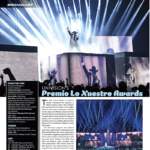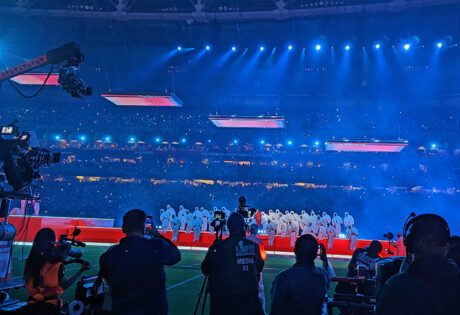
On Sunday, Feb. 12, Rihanna starred in the Apple Music Super Bowl LVII Halftime Show Starring Rihanna in a gravity defying performance on, and above the field of the State Farm Stadium in Glendale, AZ. With a design concept from Creative Director Willo Perron and Choreographer Parris Goebel, working with Creative Director/Production Designer Bruce Rodgers and Lighting Designer Al Gurdon, the 13-minute Halftime Show featured a tightly integrated production of flying platforms, a long red runway stage, and lighting that tracked Rihanna and her dancers as they performed. The production companies that supported the Halftime Show included flying platforms and the flying system from TAIT; the on field stage carts that formed the incredibly long red runway stage and the lighting carts were fabricated by All Access Staging & Productions Ltd. The lighting equipment was entirely provided by PRG. PLSN caught up with both TAIT and All Access to learn more about what they created for the dynamic show.
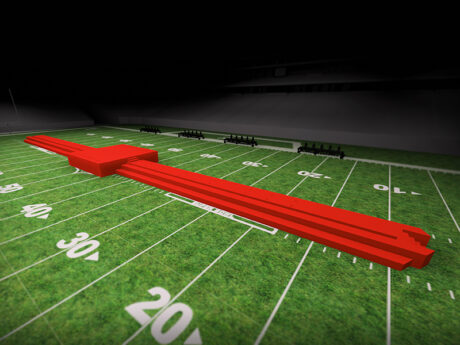
The View from the Field: All Access Staging and Productions Ltd
Back for their 13th Halftime Show, All Access provided the carts that made up the 235’ long performance stage on the field, as well as the lighting carts that PRG used to mount the lights on the field. Since State Farm Stadium’s natural grass field sits on a tray that rolls outside, the field is actually elevated by about four feet from ground level. So All Access also created a custom field access ramp, which was 14’ wide and 62’ long, to allow the set carts to roll up and onto the field.
PLSN spoke with All Access’ President, Erik Eastland about the solutions his company supplied for show.
“The stage on the field measured nearly 235 linear feet,” Eastland pointing out, “making it the widest stage of any Halftime Show. It consisted of a 31’ x 31’ square, 6’ high main center stage and runway system. Making up the stage were 15 stage carts for the main stage and runway system. Of the 15 stage carts, five were custom carts for the center stage, and four custom runway carts and one end cap cart for each side of the runway system. We also built eight carts for lighting, so there was a total of 236 wheels for all of the carts. We have specially designed turf tires for our carts to minimize the impact on the field. We also designed the carts with hinging stairs—64 overall—so the stairs could flip up making the cart narrower for storage and transportation. This kept everything self-contained and maximized the square footage of each cart. Also, all of the stairs came with flat plates at the lowest step to sit flat on the field and not do any damage. Each stage cart probably had between 16 and 20 people on it. All totaled with the lighting carts, it takes about 500 people to get the carts on and off the field.”
Working in the extremely time-sensitive Halftime Show reality for setting up and striking the stage means wanting to plan ahead to avoid any mechanical problems. Eastland noted, “The flipping stairs needed to be as simple as possible. You want to de-engineer things as much as possible, so for instance the levers to lock the stairs in the up position—those had to be super simple. I call it caveman engineering because you’ve got to keep it simple. You can’t count on anything electronic or you’re going to trigger something, and then, oh boy, if that didn’t work, you’re in trouble. So, the staging team had to manually flip and drop 64 300 lbs. stairs during load-in of the show.”
Among the many striking elements of the stage was the vibrant red color, for which the paint itself became a bit of a challenge. Eastland explained, “We used 57 gallons of premium Wildfire Luminescent paint in Bright Red. It was actually a lengthy process finding the perfect shade of red and it’s an expensive UV paint at about $250 a gallon. One challenge was that at the 11th hour during the painting stage, FedEx lost the last pallet of the paint—and there was no more of it available on the planet. It took them about a day to finally find it. However, we had to load the trucks in three days and we needed drying time and that was right when we had a ton of rain in California. We were trying to dry it even as the carts loaded onto the trucks to go to Phoenix.”
All Access also outlined the entire stage and runway system in RGBW LED tape and put four rows of LED tape at the base as well. “For this show, the LED tape was sourced from Environmental Lights, and we used Elation’s power supplies,” said Eastland. “The LED tape was Environmental Lights’ waterproof RGB + Daylight White (RGBDW) 4-in-1 LED Strip Light. We had almost 4,000’ of LED, requiring more than 12,000’ of wiring. It worked very well.”
All Access having once again delivered a memorable set successfully for the Halftime Show, Eastland wanted to add a thank you to the whole All Access team. “They did an incredible job. Tommy Rose leading the pack and all the other guys. We had 12 people out there onsite this year and then we’ve got our in-house crew that is focused solely on the Super Bowl. They don’t get any holidays, because we start working on this at Halloween, so most people don’t get to go away for Thanksgiving, don’t get to go away for Christmas, don’t go away for New Year’s, and I really want to thank them. Every one of the team was part of making it all work and it being a success.”
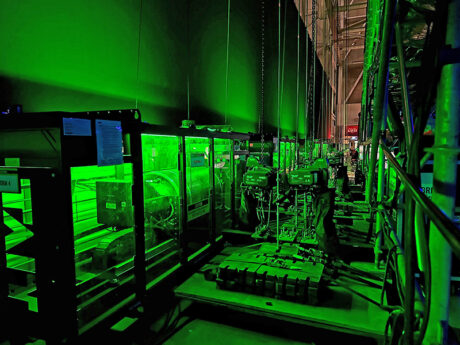
View from the Air: TAIT
For this year’s Super Bowl Halftime show TAIT fabricated the seven flying performer platforms and the flying system that made the flying effects look so effectively effortless in their fluid movement. In total, TAIT had about 40 people working onsite for a month to prep for the performance and execute the show on the day of the game. Doubtlessly, there were many more people involved who helped design, fabricate, and test the platforms at TAIT’s headquarters in Lititz, PA.
Here are some of the broad stroke numbers for the TAIT performer platform flying system, which realized the NFL’s desire to get some of the performance off of the actual field. There was 7 miles of Vectran rope; 7 active 440S Winches; 14 active Nav Hoists; 4 active Modular Winches (TAIT Navigator Camera System); 2 active 235C Winches (TAIT Navigator Camera System); 7 flying platforms that traveled up to 60’ in the air; 2 rehearsal platforms on T Winches; 14 custom arbors; 80 Kinesys LibraCELLs (one per load line and top and bottom of each travel arbor); 4 rigging points with 8 lines per platform; 7 Navigator Consoles; and 10 Navigator GUIs. PLSN spoke with TAIT’s Aaron Siebert, Project Lead, and Paul Sapsis, Technical Director about the flying system and TAIT’s work on the show.
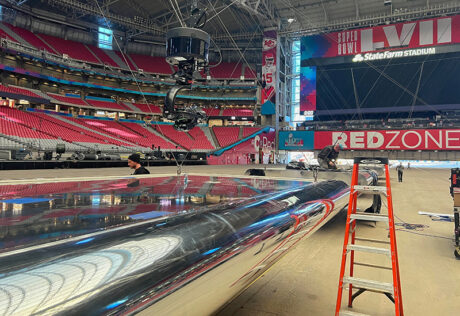
They noted that the scope of work for TAIT was providing seven flying platforms, that measured 8’ x 17’ for performers and two flying automated camera systems, and then ancillary platforms for rehearsal purposes at various venues. When asked to describe the rigging system for the performer platforms Sapsis said, “We did a lot of very conventional work to do a very unconventional thing. Think of the system, essentially as a theatrical counterweight system driven by closed loop counterweight assist winches. Then to deploy that system theatrically, we laid out points like riggers and then built trusses into the roof itself for our sheave points and for where we had to do field rigging, essentially making their grid into a theatrical grid. We had eight points per platform. Eight points, four lines a side. Then we replicate the geometry that we hit on the platform with the rig in the air. So, what we get is a one-for-one solution on line length so that we can essentially pull an arbor up and down backstage and each one of those eight lines are all moving the same length of stroke in the real world.”
Behind the scoreboard on the south 100 level of the stadium, TAIT built a fly space approximately 100’ tall by 120’ wide. The control area was 8’ wide, and underneath the press scaffolding was another 12’ of technical space that ran the length underneath all the scaffolds. Sapsis describes, “We built underneath the press area and then the furthest south 8’ of that, we put a plywood wall up behind them so they couldn’t see our gear. Essentially, that was like an elevator shaft. We had one-ton arbors traveling up and down for about a 100’ in that space.” He continues to explain how they decided to go with an arbor solution. “When we initially looked at the challenge, it become really clear upfront that putting straight lift power or hydraulics was the right solution and there wasn’t a place in the roof to do that. There wasn’t a place they wanted to see any of that mechanism. The best way to safely do this—maintaining its level and staying straight—was the absolute simplest solution. The simplest mechanics is always going to be the best way to get there, from a safety standpoint. Building an arbor and a wire guide set up became the best way to get the power we needed. The platforms, empty, are just right around 2,200 lbs. For the show, looking at what we had to do from a winch standpoint, that would have been a huge amount of horsepower. But when we threw counterweights in the mix, suddenly it was really attainable.”

They used seven independent winches to complete the counterweight assist. “We use a system called 440S, which is a winch system we initially developed for Pink’s stadium tour,” explains Sapsis. “It’s a really big, really long, fast winch. It does 600’ at 40’ per second. We took a mechanical advantage off that and connected it to the arbor; that gave us about a ton of pulling power.” Siebert told us why they chose to go with a synthetic rope instead of wire rope for suspending the flying platforms. “The self-weight of wire rope, it wants to belly so it takes a lot more force to essentially pull it through the system versus the synthetic which is easier to work with. We used Vectran Validator 12 from Sampson and it worked great.”
Being in a stadium that would allow for an open or, if weather dictated, a closed roof was also a consideration. “We were very aware of it,” said Sapsis. “When it closes and opens, the positions of the platforms change, so it was something we looked at. We ran a survey and knew the difference and knew how it would offset our system. We understood the changes and understood what we would have to do depending on if the roof was open or closed. We could adjust our stops.”
On game day TAIT had 25 people on the call during the show. There were seven people at the head block station, another six people at the winches spotting, watching the automation gear. Two people were up in the roof on a small platform at dead center standing by to call any conflicts or alert of any issues. And then another six people were in the front house booth giving commands and running the system. The TAIT team effort, both at the stadium and in the shop, certainly resulted in a dynamic and technically impressive feat of flying on an incredible scale.
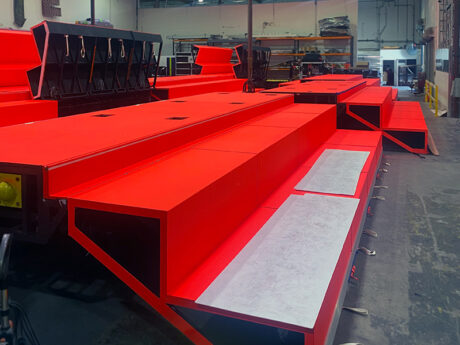
A Look Under the Flying Platform
When the design of the flying platforms was being developed for this year’s Halftime Show, the production team considered the options for putting lighting effects on the underside of them. They also need to carefully consider the control solution for the lights as well due to all of the wireless traffic of the game and broadcast systems. Lighting Director Ben Green recalls “We discussed how we could get wireless control of something in these platforms, what does the battery life look like, and how often do we have to swap the batteries. We went back and forth on a couple options and RF wireless DMX was not going to work, so we went with a PixMob solution, which is infrared light based.”
This year marked PixMob’s fifth time working to support the Super Bowl Halftime Show. TAIT installed 600 of PixMob’s new Nova LED lights underneath each of the seven flying platforms covered with a diffusion panel to create uniform coloration. There was a total of 4,200 Nova units used under all of the flying platforms. The desired effect by the production team was to have the color shifting and moving under the platforms. By using PixMob’s infrared controllers and grouping effects, they were able to create movement and different lighting patterns throughout the Halftime Show.
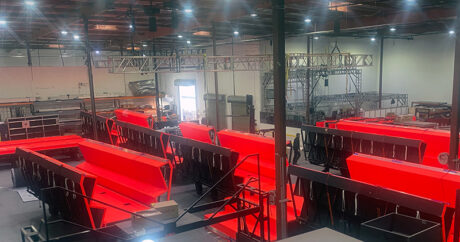
Lighting Director/Programmer Eric Marchwinski, who has had a lot of experience programming PixMob products for other shows and events, notes, “We had the ever-present hurdle in this environment with the amount of RF in this space. It’s incredibly busy and incredibly regulated because of the football game obviously, and all of the other factors that are in the room for an event like this. Wireless DMX very quickly gets put at the bottom of the list for frequency coordination. The decision was put forth to use PixMob since it’s an infrared source, and there’s nothing else out there using infrared in this way as a data stream. We’ve had quite a bit of success with this solution in this environment in the past.”

Using PixMob’s normal IR control for the Nova lights made controlling that under platform lighting effect immensely easier in an environment where wireless DMX control would not have been possible, but on top of that, PixMob would also create a quick control solution for other lighting products that the team needed for the show. “We knew we could put the Nova pixels in the bottom of the platform, that’s pretty straightforward,” describes Marchwinski. “But then we asked ourselves, ‘what happens to the LED tape on the top, via this IR bridge?’ We talked about how to maybe do this with PixMob. We’ve done a lot of work with PixMob and have a great relationship, so we asked if they could control DMX over IR, since one of the hurdles is that with IR, the bandwidth is very, very small. They found a way to reduce the DMX frame rate and gave us the ability to control DMX over IR to our devices. They came up with that solution and put it into action in 10 days, which was pretty amazing.” Green adds “That was great, because we were able to control the LED tape on top of the flying platforms that way instead of having to implement an additional wireless control system.”
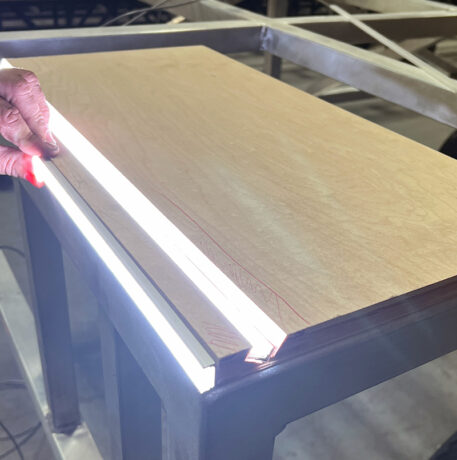
As for power, each 1.5W RGB LED Nova is powered by a rechargeable LiPo battery and holds a charge of 25 hours. Since the Nova units have a sleep mode to help lengthen battery life, the lighting team added PixMob IR wash lights from the field lighting carts to keep the Nova LEDs awake and working. “We used PixMob’s LED wash PAR, because we had to hit the underside of the platforms to wake up the pixels,” explains Marchwinski. The lighting solution looked great and added to the overall effect of the flying platforms as well as the stunning impact of the entire visual picture.
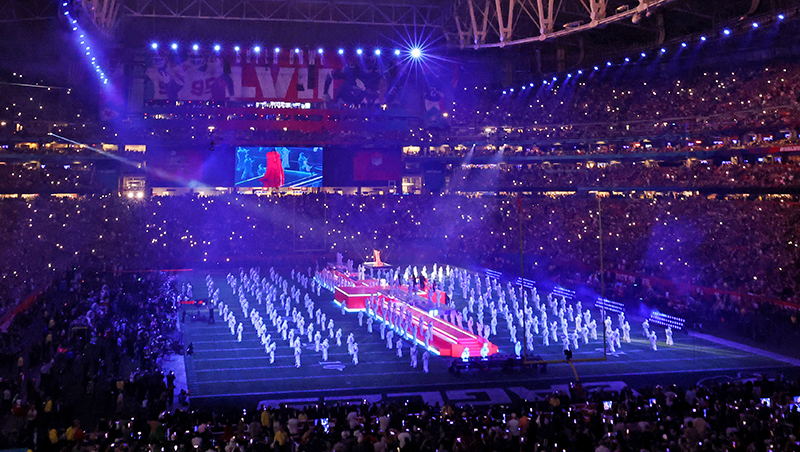
The Lighting Perspective
The lighting team for this year’s Super Bowl Halftime Show was led by Lighting Designer Al Gurdon, working alongside Lighting Directors Ben Green and Harry Forster with Lighting Directors/Programmers Eric Marchwinski and Mark Humphrey. A normal year’s Super Bowl Halftime Show usually has a limited amount of rehearsal and tech time for lighting; this year there was even less with flying rehearsals and little to no dark time. The team had only 3 three-hour rehearsals, so a lot of their work was done in previsualization and offline programming. Marchwinski and Green shared with PLSN some insight about this year’s lighting for the Apple Music Super Bowl LVII Halftime Show Starring Rihanna.
Eric, walk me through your scope of work on the Halftime Show.
Eric Marchwinski: I was the Lighting Director and the Lead Lighting Programmer, one of the two lighting programmers. I worked with Mark Humphrey, because I could not do it alone. My workflow with Al is always great as he gives me a lot of ability to be creative. We talk a lot about concept and approach, and what we want it to look like. But when it comes to the granular, cue-to-cue decisions, I’m making those based on our conversations, on the video, the choreography, and any creative notes we’ve gotten. I will then take a pass in previz of the whole show, getting us moving down the road from a cue and programming perspective.
Because of the strange environment that this gig is, where we have such minimal time on the field and a lot that has to all happen in only the 3 three-hour rehearsals, we have to do all of our homework. We need to be able to get out there and know how we will tackle all of this task list that we have to do. We came up with a workflow, so for example we knew that Mark would handle a lot of the focus and the calibration of the Zactrack system. There was so much focus that was so tightly shuttered and very specific.
Tell me about the programming and tracking of the flying performer platforms.
EM: When I saw the design, my immediate thought, knowing how little time we have and how much things change, was that we needed an active solution for how to get light onto these platforms. Because followspots were going to be incredibly messy. I have done enough lighting and tracking with PSN [PosiStageNet], as well as other tracking software and protocols, to feel confident enough to say, ‘We need this tool in this environment.’ I figured out in this case, that the right choice was Zactrack.
It’s pretty simple. We’ve done it a ton using PSN, a standard tracking protocol. TAIT tells us the absolute position of each platform. Zactrack is calibrated, so it understands where all the lights are and then it understands the point, we want to point the lights at. Then we assign the lights to that point via the console. We have a lot of control about how much influence Zactrack has. The basic signal flow is, sACN comes out of the console and Zactrack intercepts that data and then manipulates it as we ask it to. In some cases, it’s only manipulating pan, tilt, and in other cases it’s pan, tilt, zoom, and iris. It gives us the ability to crossfade between our console values and the tracking values and gives us the ability to crossfade between different trackers. We can go from one platform to another platform, with timing and cueing.
What were some key equipment choices for the show, lighting-wise?
EM: The majority of the rig is VL3600, which is a new fixture and I was super impressed with it. We had good hanging positions, good distances, and they were still quite far, but lots of transmission even in color. Then we have a whole bunch of Robe 1200 Washes, which are again a workhorse for just pouring light into large spaces. We had [TMB] Flares along the rails, which are always great for dynamic looks. Then the carts on the field had VL2600s on top and [GLP] X4s in big arrays on the bottom. Lots of fixtures we are very comfortable with as we know what they can and can’t do. No beam fixtures, this was not a very beamy show, and that’s not really Al’s aesthetic either.
Ben Green: I think the VL3600s are a great workhorse unit. I think all the manufacturers now have something in that neighborhood that’s a big stadium size workhorse that’s IP65 rated. We used more of the PRG GroundControl Long Throw followspots this year. They give us a lot more color flexibility than just tossing six gel frames in a standard followspot. Also, when the design renders came from the artist’s side, they had cool banks of light on the sidelines that looked like a stadium lighting array. We ran with that, and asked, ‘What’s something we can get a pile of to make a cool array? Something that we can do something dynamic with?’ Something that could pan and tilt and be able to run effects run across the faces of the lights. We landed on the GLP X4. We looked at the X4 L, which is obviously bigger, but the carts had size constraints for sightlines and for getting in and out of the building. The X4 was the sweet spot, and we went with three high by 15 across to create that sports lighting bank look. The [TMB] Solaris Flares are always our favorite 1,000W stadium strobe. The best part of the Flares is how narrow they are, and they throw a long way.
[Editorial note: The lighting package was supplied by PRG.]
Anything else that you would like to mention about working on the Halftime Show?
BG: This is our third year working on the show and if we get brought back next year, I am really curious to see what next year’s innovation will be. I know the NFL was pleased with having less stuff on the actual field so where do we go next from those awesome flying platforms? It will be interesting to see what will next year’s challenge be? It is a lot of fun to be part of this team and do this show, it is like nothing else.
EM: It is such an unconventional project, and it takes a lot of unconventional thinking. You’re out of your comfort zone with the way things are usually done. But we have a very strong team. I know I definitely couldn’t do my part without Mark, Ben, Harry, and Al; everybody pitching in and working together.


